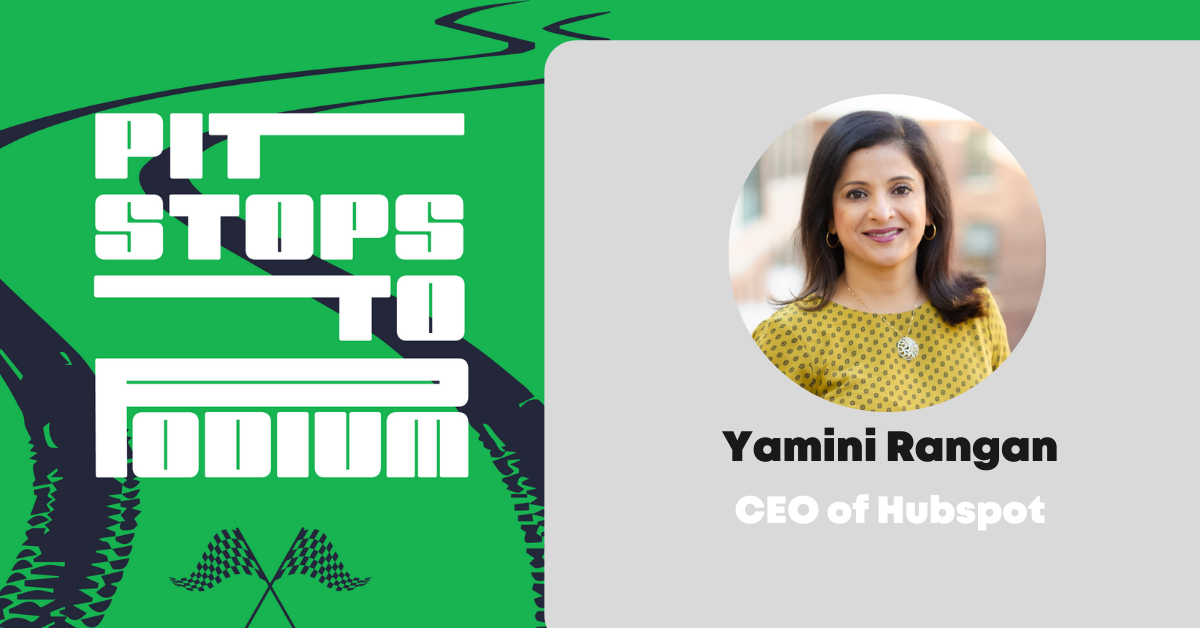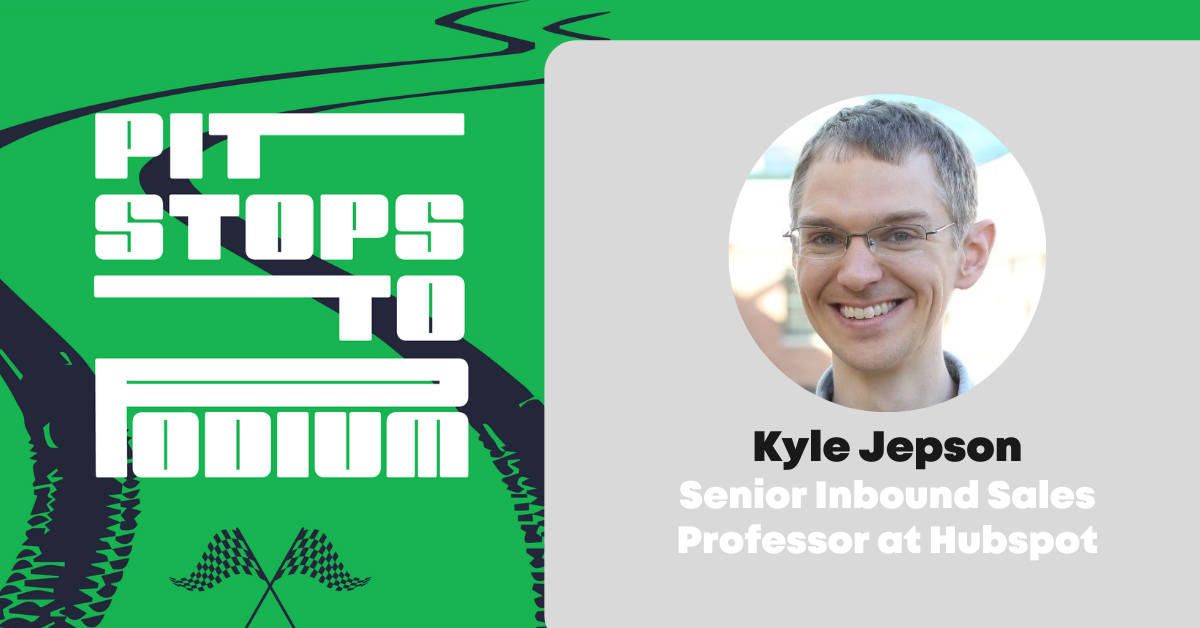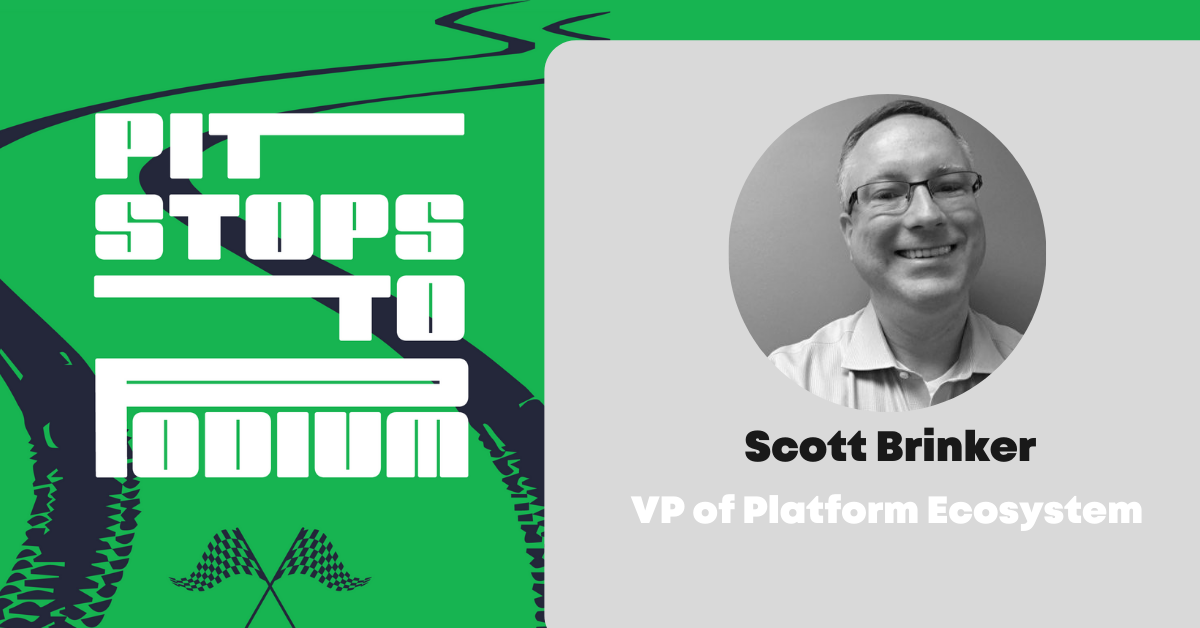Table of Contents
Many sales, marketing, and ops leaders are familiar with the term “funnel”, but the flywheel is a bit newer in the business sphere. Yamini Rangan, CEO at HubSpot, answers questions about what a flywheel is, why it matters, why HubSpot has chosen that model, and what the prescriptive process is to reach that model. Listen to the quick “Pit Stop” with Yamini and then head back to the races!
Yamini is HubSpot’s first-ever Chief Customer Officer and was named CEO on September 7, 2021. Her core purpose at HubSpot is aligning and unifying teams around the customer. Prior to HubSpot, Yamini was the CCO at Dropbox and she also served as the Vice President of Sales Strategy and Operations at Dropbox. She is passionate about all that the team at HubSpot is accomplishing and the ways they are delighting customers daily.
Pitstop Highlights
So, what is the “flywheel?”
Traditionally, sales marketing consisted of a sales funnel strategy that helped track the journey of potential customers. While this strategy was initially useful in attracting new leads and increasing conversion rates, the strategy implied a finite end to the customer’s journey. But times have changed, and Hubspot has developed a new and improved model for focusing on customer retention.
Yamini explains how the concept of the flywheel steers away from the traditional sales funnel and instead focuses on a customer-centric strategy: attracting, engaging, and delighting the right customers. With the right level of force, this flywheel begins to spin and fuel overall customer satisfaction.
Why does the alignment of teams matter?
“Alignment matters because your customer should experience the company as a whole and not as a combination of the functions that are within the company.”
Alignment is important in putting the customer first and making sure that their concerns are addressed in a way that satisfies those concerns. If the sales, marketing, and customer success teams are focusing on different goals that are not revolved around the customer experience, there is essentially zero alignment within the organization.
Vector Alignment
When looking at alignment internally, it’s important to make sure that the flywheel organization (marketing, sales, and customer success), is pointed in the same direction. The primary direction of the organization should be focused on serving customers in a “delightful” way.
How do you start the process of alignment?
There are three key steps in starting the process of alignment within your organization:
- Identify the decision-making groups
- Create a winning aspiration across groups
- Have a decision-making cadence
Connect with Yamini:
- Connect on Linkedin: https://www.linkedin.com/in/yaminirangan/
- Follow on Twitter: @yaminirangan
- Check out the HubSpot educational content on the blog: https://blog.hubspot.com/
Full transcript:
Brendan: Hey everybody, welcome to Pit Stops To Podium, the RevOps podcast where we talk to execs who compete in taking their companies from high growth to high scale. My name is Brendan Thompson and the co-founder and CEO of RevPartners, and I'm delighted to have with me today the Yamni Rangam of HubSpot for the latest episode of Pit Stops to Podium. Welcome.
Yamini: Yeah, thank you so much, Brendan. It is exciting to be here to talk to you and congrats on all of the success that you have seen as a partner this year.
Brendan: Well, I appreciate it. I think actually the congrats need to go to you. The currently serves as the chief customer officer of Hubspot, the first-ever person to serve that function. But some exciting news is that they will be the soon to be the CEO of HubSpot. So congratulations, Yamini.
Yamini: Thank you. I really appreciate it. It's all happening.
Brendan: Yeah, I'm sure you're quite busy right now. When Jamie's role in that chief customer officer was really around, you know, her focus of aligning and unifying teams. And prior to the Hubspot, Yamini served a similar role at Dropbox as CCO and even as a VP of sales and strategy, operations at Dropbox. As we get started, you know, especially as you've been a chief customer officer moving into that CEO role, you have a unique lens on who HubSpot is. So in your own words, how would you describe HubSpot?
Yamini: Hotspot is really the CRM platform for scaling companies. And Brendan, we are in the age of the customer, and in the last 18 months have shown that you really need to be digitally connected to all of your customers. And so HubSpot provides all of the front office digital tools needed for our customers to stay connected with their customers.
Brendan: You know, you're right. I mean, it is a digital landscape now, and especially in light of COVID. If you weren't digital first, then you have certainly had to embrace that concept. And so HubSpot is a great solution to unify the entire customer journey. Well, Yamini, before we get into this big idea, we do have a tradition here at Pit Stops to Podium to understand our guest outside of work. What are three fun facts that our audience should know about you?
Yamini: All right. I like this question. I'll tell you, like the first one is that I never intended to be in technology. When I was growing up, I thought I wanted to be in design and architecture. I was kind of obsessed. I used to carry around a notepad and always be drawing buildings and people. And so that was like, that's a fun fact. And I still like scribbling and drawing, so that's one. The second thing I would say is that, you know, I am a non-caffeine person. I typically don't have any caffeine and I start very early. I work in the West Coast for an East Coast company, so I'm up pretty early, but no coffee or tea. However, because I live in California and I spent a bunch of time in Napa, I am certainly in favor of wine. That's my favorite drink. That's the second fun fact. And then I will say that I've got the third one is not as a fun fact, but just getting to know me personally. I am the mother of two boys, 14 and 12. They are super active. We we all love being active. So most of the time, you'll find it's like being outside the house, hiking or in some sports.
Brendan: So what's your what's your favorite hiking spot?
Yamini: You know, honestly, various is like amazing for it, so we're constantly looking up new trails to go to. We recently went to Yellowstone National Park and a bunch of bikes there and was just beautiful.
Brendan: So, yeah, that was one of the hobbies that my family picked up during COVID. Granted, my kids are a lot younger than yours, but there are some benefits, too to what COVID created, and certainly that was one of them for us. So that's great. Well, thank you for sharing a little bit more about you outside of Hubspot. Let's transition into the big idea here. This is something you're passionate about. And also, I know it's something that Hubspot was really passionate about. That's how to align your teams around the flywheel.
Yamini: Yep.
Brendan: And so as we get started, the Omni, let's really define what is the flywheel. I know it's something that I've talked a lot about, but I'd love to hear how you think about that flywheel.
Yamini: Yeah, it's a great question. A number of HubSpot customers probably heard us talk about the flywheel three, four years ago as we started with the concept of flywheel. Looking back now. Brendon, you've been in sales for a very long period of time. Now, in order for us to understand flywheel, you have to actually think about what is not. The flywheel and funnel is not the flywheel. And that's how traditionally in sales marketing, we used to look at everything right. We would start the funnel. We would look at what is top of the funnel. How do you convert all of those into customers? And at the end of the bottom of the funnel, you have a customer one you celebrate with that gong, a bell, you know, are involved. And then what happens to the customer? Not much. So that's what, you know, not having a flywheel. Therefore, when we started thinking about the concept of the flywheel, we wanted to put the customer at the center of the flywheel and ensure that marketing does everything to attract the right kinds of customers. Sales does everything to engage the right kinds of customers, and customer success is oriented around delighting the customer. And all of this with the customer at the center. What ends up happening when you delight your customers and that becomes the focus of the organization is you create a flywheel. And what happens with the flywheel, with the right levels of force and with the reduction of friction, flywheel begins to spin. And so for us, we oriented our products and our go-to-market around this concept of putting customers at the center and really fueling the flywheel by making customers really delighted.
Brendan: Yeah, I love the concept, and you're right, I mean, traditionally in sales, you do think about the funnel in terms of, hey, if I bring in hundreds leads, how many of those do I convert? But it implies that there is a finite end to that engagement. And by putting the flywheel first and ultimately the customer first, it assumes that there is an entire journey that you are embarking upon, which ultimately only delights the customer. But it benefits you because it creates either expansion, upsell or that word of mouth referral that you otherwise wouldn't get if you're just doing it purely as a transaction.
Yamini: Absolutely absolutely. That's exactly right.
Brandan: So let's transition. So we do. We define what the flywheel is. We were talking about alignment. So why? Let's start with the why? Why does alignment of teams really matter? I like the fact that you're starting with the why and we could probably do multiple whys around the same question. Why it matters is your customer should experience the company as a whole. And not as a combination of the functions that are within the company. That is why alignment matters. And so you take the concept of the flywheel you started putting your customer at the center. But if your marketing still focuses on leads and sales still focuses on their monthly quota and your customer success and service still focuses on their metrics, maybe see stat or NPS, you're still not there optimizing for your end customer. And so alignment is exceptionally important to really take the next steps to bring the customer at the center and delight the customer in a typical organization, Brendan. If you go and ask your head of marketing, what's your goal? Head of sales? What's your goal? Head of customer success? What's their goal? If that goal does not have the word customer in it, then there is no alignment. And that's what we so organizations like, they'll say something about leads and, you know, targets and ZAP and something like that, but it needs to have the word customer. And so that's where you got to begin the journey of alignment because unless you have alignment, your customers are still going to experience or organization as someone pass.
Brendan: Well, yeah, I think it speaks to that customer journey and you talk about, you know, creating a frictionless experience, a lot of times what we call that is the friction tax. And you know what, that ultimately creates leakage because it's a bad experience for the customer. And you talk about this idea of vectors for the team. Can you expand on what you mean by that from a vector standpoint?
Yamini: Vector is basically, you know, just pointed in the same direction. Right? you know, if you think about all of these organizations, we talk about vector because it shows the direction that their point of view and the magnitude of the force that helps that vector particularly move. And so when we, you know, look at alignment internally, we want to make sure that the flywheel organization. And we did end up creating a flywheel organization internally, which is marketing, sales, customer success. We want them pointed in exactly the same direction, and that's what we mean by the vectors are aligned and that direction is serving our customers in a delightful manner. That is our winning aspiration. So when we started this journey not dissimilar to a lot of our customers, we had very different goals and then we came together as a flywheel team and we said, what does winning look like for our entire flywheel organization came down to focusing on the customer and delivering a delightful customer experience. So whether you are in marketing or your sales or your customer success or your revenue operations supporting any of these teams. The ultimate goal that we care to really focus on is delighting the customer experience, and that points to that level of vector alignment.
Brendan: Yeah, it's a really good segway into the next or the final idea that we have, so we understand what the flywheel, what the flywheel is, why alignment is so important. And then ultimately, what do you do about that? And so you kind of tease that out a little bit in terms of HubSpot driving their teams around this alignment concept. What are some practical applications, some insights that you've seen in your experience that would be helpful for our audience as to how do you break down those silos to scale?
Yamini: Yeah, and you've got to break it down, right? This is not so complex. The first step in the journey is understanding why you have to do it, which which we talked about, which is, you know, that's how you serve your customer. The next step in the journey is to breaking it down into practical steps. What has worked for Hubspot, what I would ideally suggest our customers, prospects look at is, who is the decision making group at hubspot? The decision making group was neither marketing leader, a sales leader of customer success, leader or revenue operations. These are the folks. And so whether you bring them together, like we did under an organization or you bring them together as a decision making group, that's the first step. Bring together the folks that are responsible for decisions around the customer experience together in the group. The second is actually creating a winning aspiration, which we talked a little bit about. What does winning look like across all of these groups that are serving the customer? In our case, it's delivering a delightful customer experience. The third step in the process is actually having a decision making cadence. In our case, it's biweekly. This group gets together. We look at the most critical metrics that measure our impact on the customer's experience, and we also look at the key initiatives that we are driving that support the customer experience. And between all of that, we know the kinds of decisions we need to make. And Brendan, it actually came into being very quickly. Last year, we started the year we pulled all of these groups together. And in March, as you know, the world was kind of struck by a pandemic. And so it was very timely to have this decision-making group. And in a matter of five days, we made decisions that would typically take five months during a planning cycle. We made decisions on how to support our customers during a very turbulent time, how to support our partners again, provide a level of safety for our partners, making sure that we made changes in pricing, and making sure we made changes to our product. All of those decisions happened with this group, and so the practical steps are identified, the need to create a group that is the decision-making group, identify the winning aspiration for the group, and made a decision making cadence where decisions can happen quick and fast and still centered around the customer.
Brendan: That's great, thank you for giving such a practical application, I'm a geek for a framework. And so that prescriptive process will certainly be applied not only for me, but I'm sure to the rest of our audience. I really do appreciate you taking the time to share your experience with HubSpot and how you've been able to drive alignment within the organization. What are practical ways in which our audience can engage with both you and with Hubspot?
Yamini: With Hubspot, I mean, follow us all over the digital presence. I think our blogs, our educational content, any of that would be absolutely the ways that you can keep in touch with us. And we are committed to kind of educating and inspiring all front office workers globally. So that is great. And in terms of me personally, I'm on Twitter and I'm on LinkedIn. And if any of this resonates with you, follow me and I write a lot about all of the stuff. This is my passion and, you know, definitely follow.
Brendan: Well, Yamini, Thanks again for joining us and congrats again on the exciting news at HubSpot. We know you'll do great things. And Thanks for stopping by. Thank you so much. Thanks for having me a pit stop and really appreciate the work that you and the whole team does.
Yamini: Thanks a lot, Brandon. Thank you.
Want to hear from industry experts?
Come check out the full Pit Stops to Podium podcast repository!

.png)


